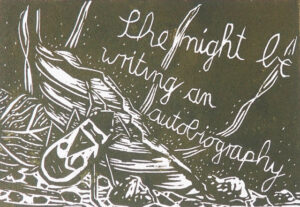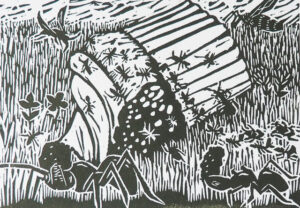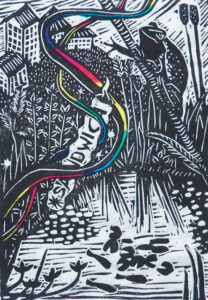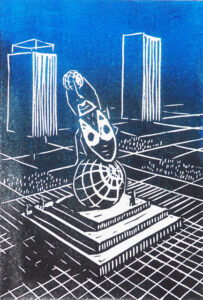This is a contribution by Charlotte Dorn, a researcher in the arts, seeking to create images of animals that invite us to rethink our relationship with non-human nature.

“It matters what matters we use to think other matters with; it matters what stories we tell to tell other stories with […] what thoughts think thoughts […] what stories make worlds […].”
Donna Haraway, Staying with the Trouble. Making Kin in the Chthulucene, Durham-London: Duke University Press, 2016, p. 12.
Speculations about what other animals might be doing when humans aren’t watching or about behaviour we don’t understand are part of a research process on how to increase the empathetic engagement with other-than human animals. Fantasies about what they think, what personalities they might have, and how they structure their lives are mingled with concrete experiences with insects and ethological knowledge about the species. These stories are told to form new connections and strengthen ecological awareness.
The method is inspired by the artistic method speculative fiction or magical realism, where the real world is permeated by magical aspects. The illustrations visualize possible scenarios of insect existences. The concept of telling fictional stories about the human-animal relationship is inspired by Donna Haraway’s “speculative fabulation” (2016, p. 2), which involves telling stories of coexistence between humans and other animals. The term “Chthuluzän” introduced by Donna Haraway (2016, p. 2) is an example of how the invention of a new word leads to a different perspective on the current status. Creating original connections by intertwining the real with fiction, promotes openness and flexibility towards the present and future.
“[…] I look for real stories that are also speculative fabulations and speculative realisms. These are stories in which multispecies players, who are enmeshed in partial and flawed translations across difference, redo ways of living and dying attuned to still possible finite flourishing, still possible recuperation.” (Haraway 2016, p. 10)

Just like Donna Haraway, I believe that we need more narratives that explore the mutual influence of the human and non-human, as well as the significance of non-human agency and its interference with human life (Haraway 2016, p. 10). The more multispecies stories are told, the more diverse, richer, multi-layered, interconnected the world seems. Speculating about possible futures counters the resignation and hopelessness that can be felt when discussing the climate crisis or species extinction. Moreover, aside from raising awareness for non-human existence, storytelling can also lead to concrete proposals for better future coexistence.
By visualizing ideas for a future coexistence grounded in a greater appreciation of the interconnectedness between human and non-human existences, I give shape to these ideas and make them more tangible.

The linocut, created in the framework of a Biofutures Living Lab workshop at the KU Leuven in 2023, illustrates the fictional story around a new, green energy source called Aurora Benergy and a relational policy instaured by humans to take more serious other than human wants and needs. In this illustration on the left a Grog named Gregor is talking with Aurora Benergy. The energy source complains on the increasing workload, as humans are using more and more energy.
In the light of a potential energy crisis, ideas were gathered and developed in groups during the BioFutures Living Lab workshop to find solutions to some of the ecological crisis’s challenges.
“Amidst the pervasive pessimism surrounding potential futures scenarios, the imagination of constructive trajectories becomes increasingly challenging: ‘how can we begin to move towards ecological and cultural sustainability if we cannot even imagine what the path feels like’ (Wall Kimmerer, 2013, p. 6)? In order to encourage citizens to re-think their position in this world and imagine more positive futures of ecological balance, we propose to experiment with the lens of futures thinking and imagination.” (Biofutures Article 2023, Introduction)
The concept of this workshop was based on future studies, participatory design, bioart, as well as the theories of posthumanism and new materialisms. The three-day BioArt Living Lab was structured into five steps: “identifying the problem, framing new approaches to tackle the problem, co-researching and co-designing potential pathways to deal with the problem, evaluating and reflecting on these new pathways, and sharing of results (The Bristol Approach, 2023).” (Biofutures Article 2023, Methodology) Through speculative design, future objects were invented, with a particular focus on multispecies connections. Subsequently, potential benefits and risks of these objects were imagined, their integration into society was considered, and a fictional story with the object involved was written. (Biofutures Article 2023, Methodology)
Whilst the BioFutures workshop included thinking about non-human existences as only a part of the program and rather concentrated on an energy black-out, my research focuses on envisioning a future in which other-than-human existences are acknowledged and valued. The creative and thinking process of speculation is rooted in compassion meditation (Lobsang Tenzin Negi, CBCT) and an awareness of unnecessary animals suffering whereas in the BioArtLab, the speculation begins with a potential energy catastrophe that puts a stop to human current lifestyle. Also, in difference to BioFutures Living Lab, my research explores aesthetic questions about representing insect personalities and their coexistence.
The works speculating about the lives of insects present more and less likely scenarios, illustrating the diversity of possible modes of existence. Particularly, seemingly less likely speculations invite to be open to the realm of possibility. As Violette Pouillard mentioned, it’s not necessary to ‘know everything’ or ‘as much as possible’ about other animals to envision a future with them and respect them. Not knowing everything can even contribute to approaching others with greater caution. Furthermore, in sciences, non-human existences are predominantly examined for their utility to humans. Imagining situations independent of humans shows that animals lead lives beyond human utility.

The visualization of ideas that sensibilize to multispecies worlds are visualized through graphic art. The artistic transformation of ideas into a tangible object anchors thoughts in the material world and can be used for dissemination. The artwork is an object that invites for open-mindedness and highlights the content as a subjective perspective. Not portraying one’s own opinion as an absolute fact helps to take other perspectives seriously and encourages a closer examination of the other and the own standpoint. At the same time, one has to accept that opinions can change, thus one has to continuously question the own perception. Also, the artistic representation of an idea helps to emotionally and intuitively open up to the displayed content. Learning to confront other animals with emotional openness by being confronted with their artistic representation is one of the aims of this project.
Cultural depictions of bugs can be found in Klaus Reinhardt’s work Literary Bugs: An Anthology, Along with a Brief Natural and Cultural History (2014). He collects literary portrayals of bugs, such as Tolstoy’s The Cossacks: A Tale of 1852 (1875). In The Cossacks: A Tale of 1852, Tolstoy unsuccessfully tries to avoid being bitten by bugs that live in his bedroom and resigns with the thought, “you cannot outsmart them” (2014, p. 127). So, the author tells a realistic story about bedbugs without devaluing them, but portraying them as intelligent beings capable of evading human traps. Such a perspective, which does not present bugs from a perspective associated with disgust, serves as a source of inspiration for the own project.
A point of criticism of this method could be that it does not pay enough attention to the real life of the animal as the fictional elements divert attention from the real circumstances of these animals. The counterargument is that the goal of this project is not to depict insects as realistically as possible, but to playfully anchor non-human worlds in our consciousness and build a relationship with them. For this purpose, stylistic elements are used that show bugs in ways we don’t experience them in everyday life but are helpful in portraying bugs as individuals with agency. This connection with the other created through art can then strengthen the relationship with living animals in everyday life.
Another criticism could be that the portrayal of bugs is anthropomorphizing, for example, when two bugs are depicted communicating with each other through human language. However, this visual representation is not suggesting that bugs speak human language but rather that there is communication between bugs. Human language and a comic-like style are used to narrate a story that is understandable for a human viewer.
Charlotte Dorn